|
Stein of the Month: August 2000 |
~ The St. Florian Stein ~
by John Aschenbrenner
This article was published in Prosit, March 1994
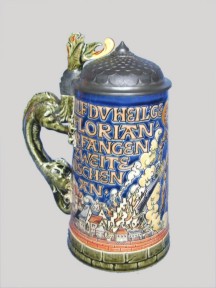 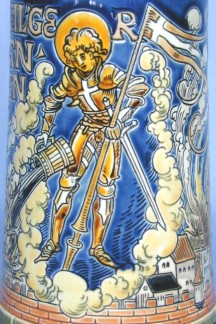 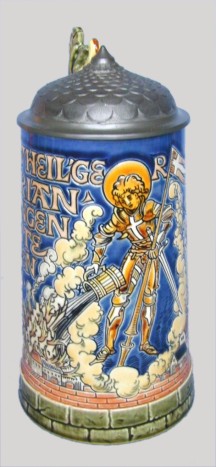 |
Saint Florian and His
Second Dousing of the Flames
Mettlach stein number 1786, the St. Florian stein, is one of the most beautiful and skillfully crafted, etched and glazed steins produced by Villeroy & Boch during its "Golden Era", with artistry attributed to Otto Hupp. The stein first appears in the 1899 Mettlach Catalog, though the one upon which this article is based is dated 1896. It is � liter, and measures 22 cm., though it is also found in the 1 liter size, measuring 28 cm.
This incomparable stein features a grotesque fire-breathing dragon handle, clawing its way up the rear of the stein and over the pewter lid, fashioned as a tiled rooftop. The ferocious creature has set fire to the village featured on the body of the stein. Flames and smoke leap through windows and across roofs, threatening the steepled church. Through the smoke and hovering above the disaster, Saint Florian appears and rescues the village. Florian is dressed in Roman military garb, holding the Flag of The Church atop of his spear in his left hand and dousing the fires from a bucket held in his right. The inscription reads:
Hilf Du Heil'ger Florian. Wir Fanger 'S Zweite Loeschen An.
which translates as "Help, O Holy Florian. We are beginning the second dousing.
The second dousing? What could that possibly mean. Wouldn't one dousing of the fires from the hands of a capable saint be more than adequate? Obviously there is a double meaning behind both the inscription and the saint featured on this Mettlach stein, It may not be much of a mystery for the Austrians, Germans and other Europeans, in whose countries Saint Florian is very popular. However, in the United States little is known about Florian, and few could guess the meaning behind the "second dousing". We need to go back in time to the late Roman Empire in Austria. Thanks to the research information given me by St. Florian Church in Milwaukee, we find that:
"Austria as a Roman province was called Noricum. The capital of the northern portion of the province was Lauriacum, located at the confluence of the Danube and Enns rivers. Today the people call it Lorch. A large garrison of Roman soldiers lived there, and their commander was the governor of Noricum.
In the early days of his reign Diocletian, the Roman emperor, had tolerated Christians, but trouble was brewing. Slowly the Christians who were serving in the Roman armies were being dismissed. The blow fell in A.D. 303 when Diocletian published his edict outlawing Christianity. Churches were to be destroyed, religious assemblies were forbidden, religious books were to be burned, stubborn Christians were to be hunted down and executed. The persecution did not stop at the ancient gates of Rome - it quickly spread to the provinces.
The zealous governor of Noricum, intent on ingratiating himself with the emperor, was quick to enforce the imperial edict. He ferreted out the Christians who were enrolled in the army and had them thrown into prison to await execution.
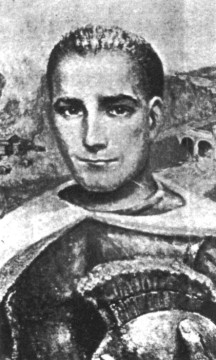 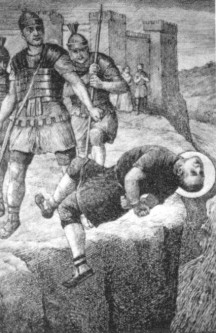 |
Legend has it that in Lauriacum many useless efforts were made to cajole Florian into renouncing his faith by sacrificing to the Roman idols. In exasperation the governor had him scourged, but Florian remained steadfast in his belief. No alternative remained; the governor had to pronounce the death sentence if he intended to remain in Diocletian's good graces. The soldiers led him to a bridge over the Enns river, fashioned a large millstone to his neck with a rope, and cast him from the bridge to his martyrdom. His body was washed ashore, regardless of the weight of the stone, and it is said that many miracles were worked at the grave of Florian.
In addition to being chief patron of Upper Austria and a major patron of Poland, Saint Florian is protector against fire. He has been patron of firemen and of chimney sweeps since the 12th century. Why? One old writer explained it thus: "Stone is the result of fire's activity; a stone had weighed down the body of the Saint, but the water had conquered the stone by depositing the body on dry land. Thus water conquered fire, and Florian is protector against fires!"
Austrian folklore, usually so prolific, says nothing about the martyrdom of St. Florian, but the country folk do invoke his name when they are threatened by fire or flood, and they still appeal to him in characteristic ditties such as:
"Oh thou Holy Florian, spare our cottage, burn the other one!"
Recent archeological work around Lorch has substantiated several details of the legend. Florian was a historical personality. At the time of the Diocletian persecution he was director of government offices in Cetium. He was martyred in 304 at Lauriacum by being drowned in the Enns river. Devotion to him has always flourished in Austria and Poland."
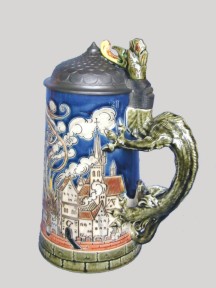 In
my own travels I have seen fresco paintings decorating firehouse walls in
Bavaria. A likeness of the Saint is found in many churches, and in almost any
woodcarver's shop you will find brightly painted carvings of Florian, wearing
the armor and feathered helmet of a Roman soldier, leaning on a tall spear held
in one hand, and with the other pouring water from a bucket onto a miniature
burning building.
In
my own travels I have seen fresco paintings decorating firehouse walls in
Bavaria. A likeness of the Saint is found in many churches, and in almost any
woodcarver's shop you will find brightly painted carvings of Florian, wearing
the armor and feathered helmet of a Roman soldier, leaning on a tall spear held
in one hand, and with the other pouring water from a bucket onto a miniature
burning building.XBut how and why does Saint Florian find his image etched onto a beer stein? The answer also gives meaning to the mysterious inscription on Mettlach stein number 1786, "We are beginning the second dousing." Not only is Florian the official patron of Upper Austria, Poland, and of firemen and chimney sweeps, he is also the unofficial patron of beer drinkers! The "second dousing" can refer only to dousing the fires that occur in the throat! Could there be any better way, other than with a Mettlach stein etched with the likeness of St. Florian, filled with a German brew, and with the owner's own hand squeezing the life from the fire-breathing dragon?
Help, O Florian! Keep the burning flames from our throats!
Thank you for research assistance to the St. Florian Catholic Church in Milwaukee.
|
All rights reserved. |